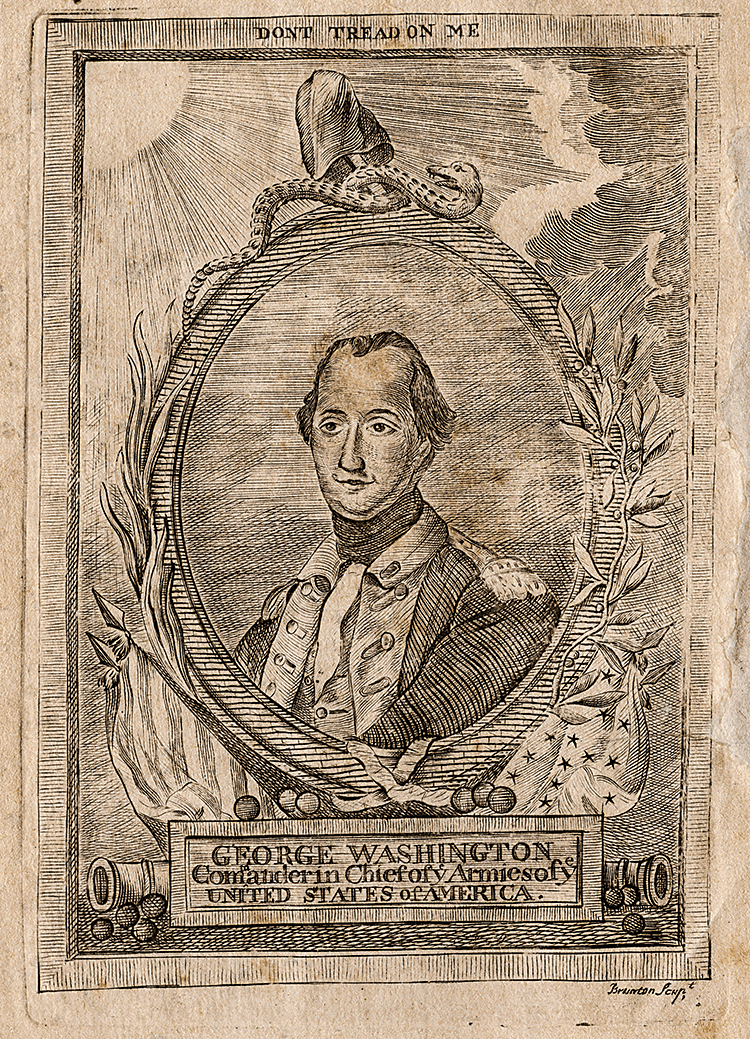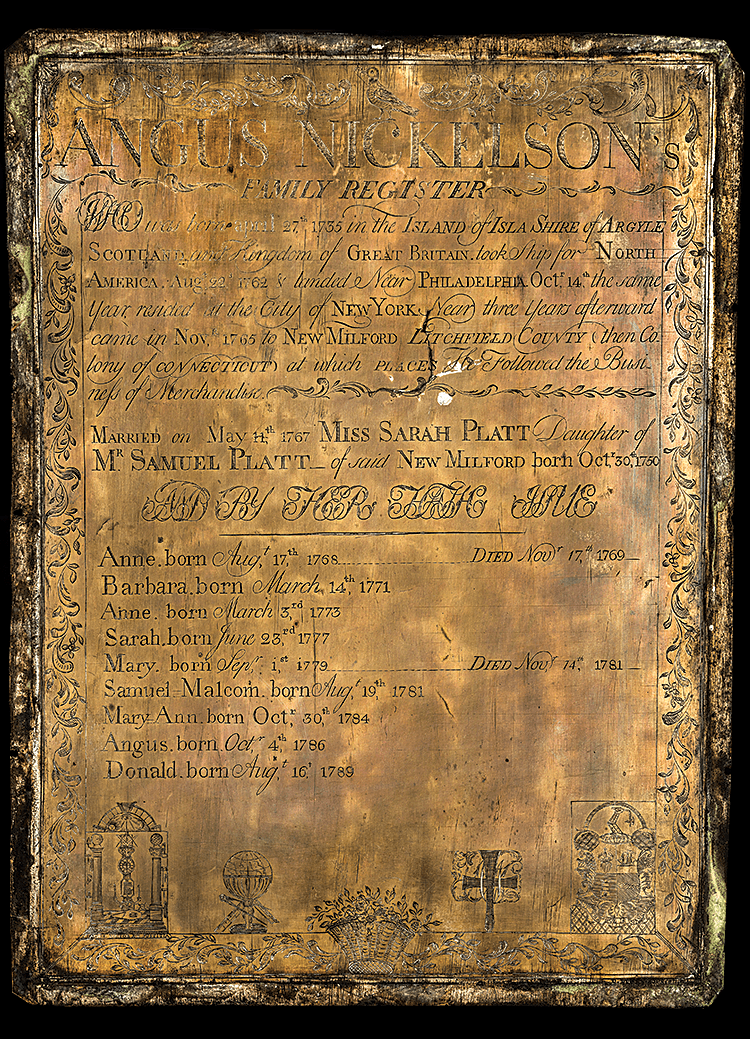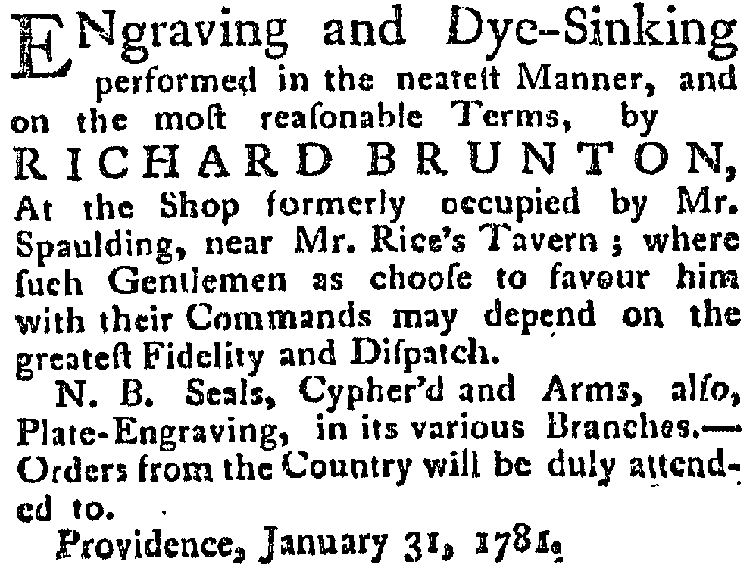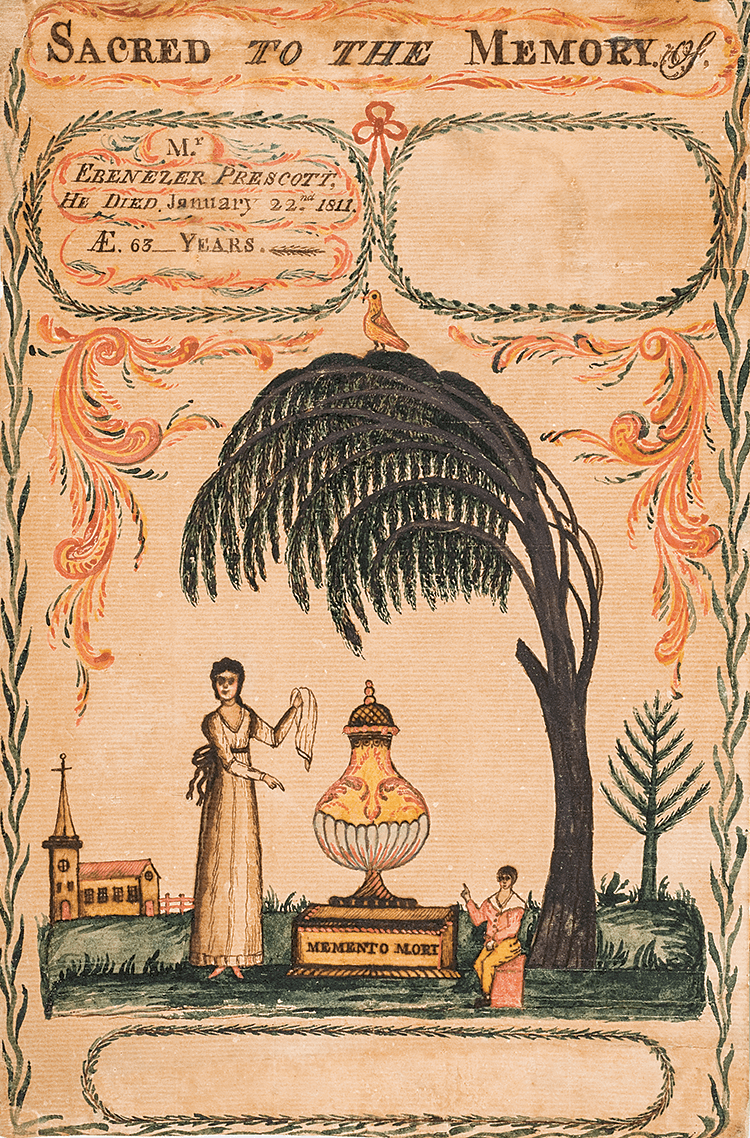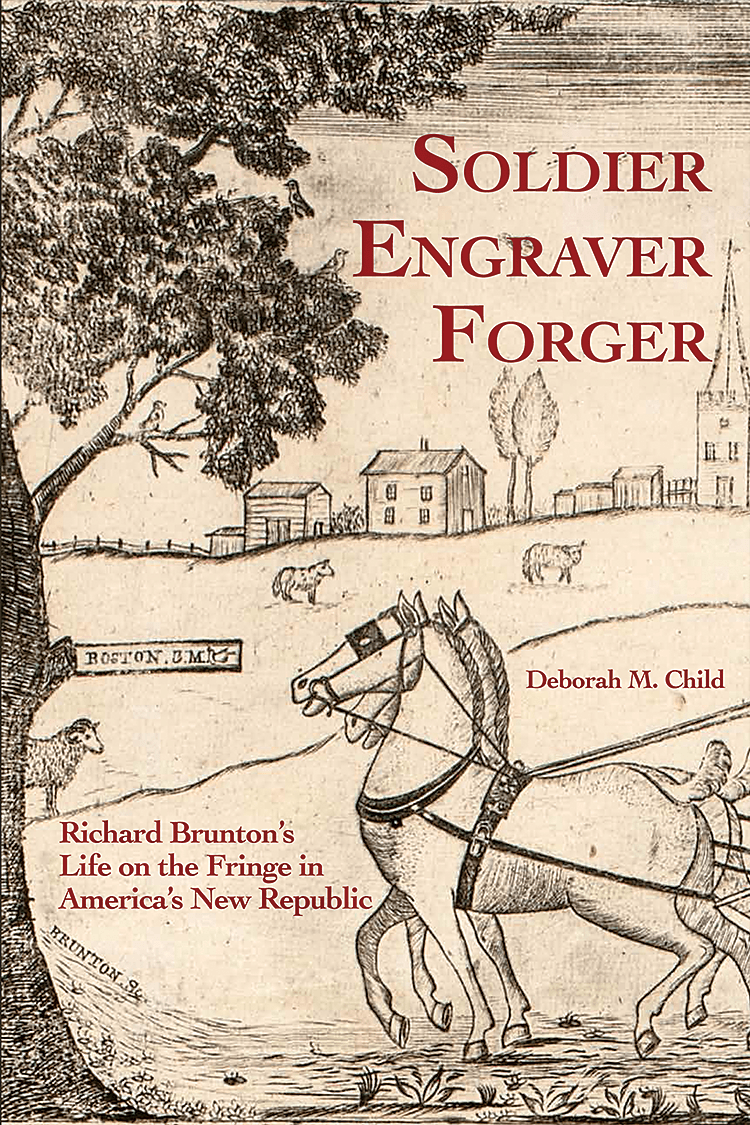Scoundrel, Artist, or Both? The Tale of an American Folk Artist
This archive article was originally published in the Autumn 2015 issue of Antiques & Fine Art magazine.
When Richard Brunton sailed into the port of Boston in July 1774, he was twenty-five years old and had served in his Majesty’s 38th Regiment of Foot in Ireland for at least a year before his regiment was dispatched to bolster the British military presence in the colonies. In the ensuing years, he lived a life rich in drama, if not in morals or material goods.
Brunton was soon at the forefront of some of the bloodiest battles of the Revolutionary War—including the Battle of Breeds Hill (aka the Battle of Bunker Hill) until June 1779, when he deserted his unit at Verplanck’s Point, New York.1 What prompted him to desert is not known. Nor is it known how Brunton (aka Brinton and Brenton) spent the time until his marriage to Polly [aka Mary] Fullerton in Boston on October 14, 1779.
Boston was a good choice of destination for Brunton. The British Army had evacuated the city in 1776, and he could move about safely and even use his own name. He knew the city well and still had contacts there in the trades who might help him secure work as an engraver and dye sinker. The latter involved making dies for stamping or embossing designs on coins, medals, and buttons, a craft for which he had apprenticed in in his native Birmingham, England,2 a leading exporter of jewelry, plate, hardware, buckles, watches, and chains to the colonies.
From March 20 through May 4, 1780, an advertisement in the New-England Chronicle cited “Engraving, Jewellary [sic], and Silver-smiths work” by Brunton, Gordon, and Quirk, on Quaker Lane, opposite the Quaker Meeting House in Boston. Like Brunton, James Samuel Gordon trained in his craft in England, arriving in 1769 as an indentured servant to Philadelphia silversmith Edmund Milne. Quirk’s identity remains a mystery.
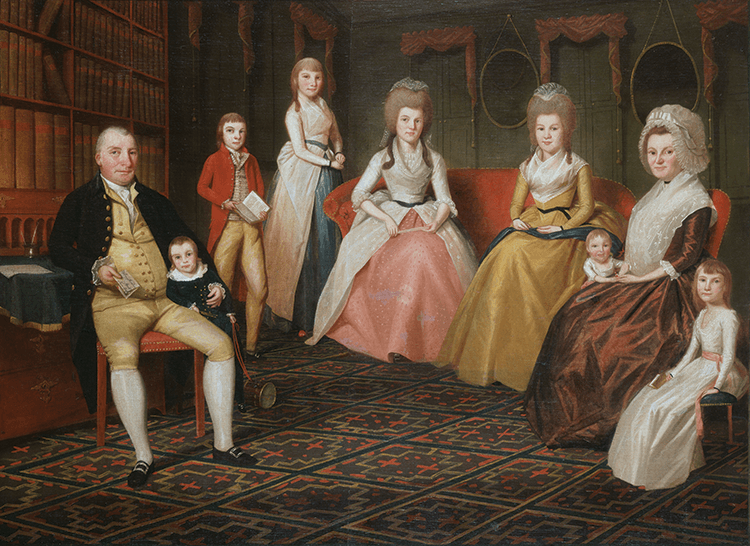
- Fig. 4: Ralph Earl (1751–1801), Angus Nickelson and Family, ca. 1790. Oil on canvas, 42½ × 58 inches. Courtesy of Michele & Donald D’Amour Museum of Fine Arts, Springfield, Massachusetts. Gift of Robert L. Munson (69.01). Photography by David Stansbury.
The life dates of family members recorded on Brunton’s register (Fig. 3) make it possible to identify every sitter in this English-inspired family portrait by Brunton’s colleague Earl.
The trio’s operation soon folded, prompting Brunton and his wife to leave the city for Providence, Rhode Island. Perhaps the fact that the city was under the guardianship of a French garrison was a factor in their choice3; it is noteworthy that in his 1781 advertisement (Fig. 1), Brunton neglected to include his place of origin. Not only would Brunton be protected from British officers, French troops stationed in Providence might have ready money to seek out his services.
Despite praise for his copperplate engraving undertaken for a local publisher (Fig. 2), Brunton was unable to make a living wage and secure legal domicile in Providence.
In January 1783, Brunton and his expectant wife undertook a seventy-mile journey north to Groton, thirty-five miles northwest of Boston. On arrival there, their reception proved less than welcoming: “Richard Brunton and Mary [Polly] his wife, last from Providence in the State of Rhode Island, warned out of Groton on January 26, 1783.” 4 By issuing this warning, the town divested itself of any legal responsibility for the care and support of Brunton and his family who had no familial ties to the town and no viable means of support.
These proved to be dire times for the couple. Brunton’s wife delivered a son, whose death was recorded in the neighboring town of Pepperell on March 5, 1783.5 It is the second and last record of her. After this date, the couple either parted ways or she, too, died.
The following year, Brunton and his old partner Gordon were paying taxes to the town of Pepperell and may have been fashioning coins from gold and silver deposits being excavated from the Heald mine in Pepperell.6 Given the dearth of hard currency in the region, such an operation may well have been sanctioned by the locals. This may not have been the first time Brunton had turned his hand to counterfeiting coins. Birmingham diesinkers were skilled at making false coinage that looked already worn when struck.7 But the promised yields from the mine never materialized, and the operation reportedly soon shut down.
With no ties to bind him, Brunton left Pepperell in the spring of 1784. As he made his way westward, it is perhaps no coincidence that warnings of counterfeit money began to appear in the press wherever he was. Undoubtedly, Brunton was dispersing coins he and Gordon had made.
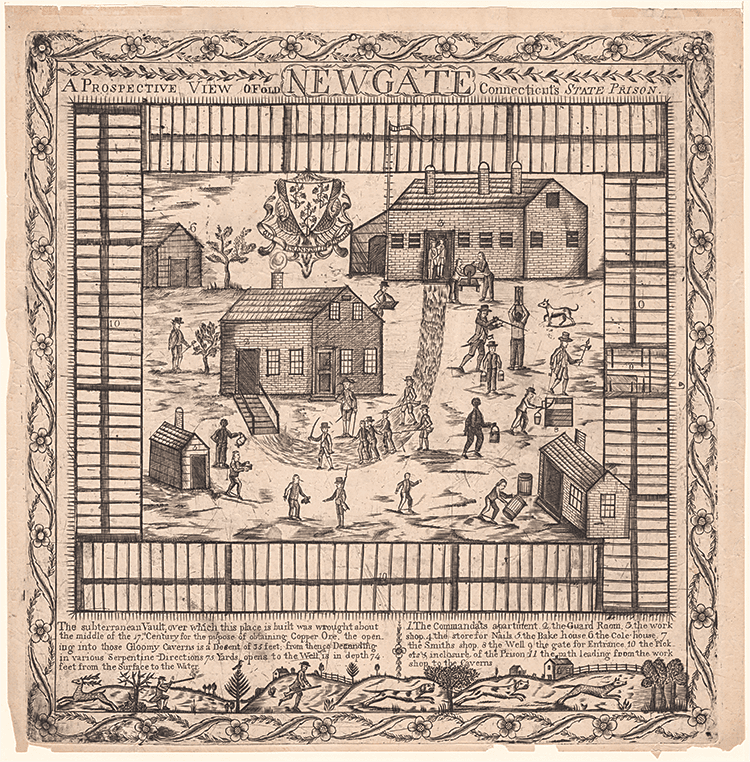
- Fig. 5: Attributed to Richard Brunton (1749–1832), A Prospective View of Old NewGate, Connecticut’s State Prison, Granby, Conn., ca. 1799. Line engraving, 20½ × 20¼ inches. Courtesy of the Connecticut Historical Society, Hartford (1859.3.0).
This is Brunton’s most elaborate and largest engraving extant. Primitive as the perspective may be, it clearly shows the wooden palisade fence with spikes that surrounded the prison prior to the erection of a steep stone wall and gate in 1802. Only two other original impressions are known. In 1870, another six to eight impressions were taken before the actual plate was moved to Boston and cut up.
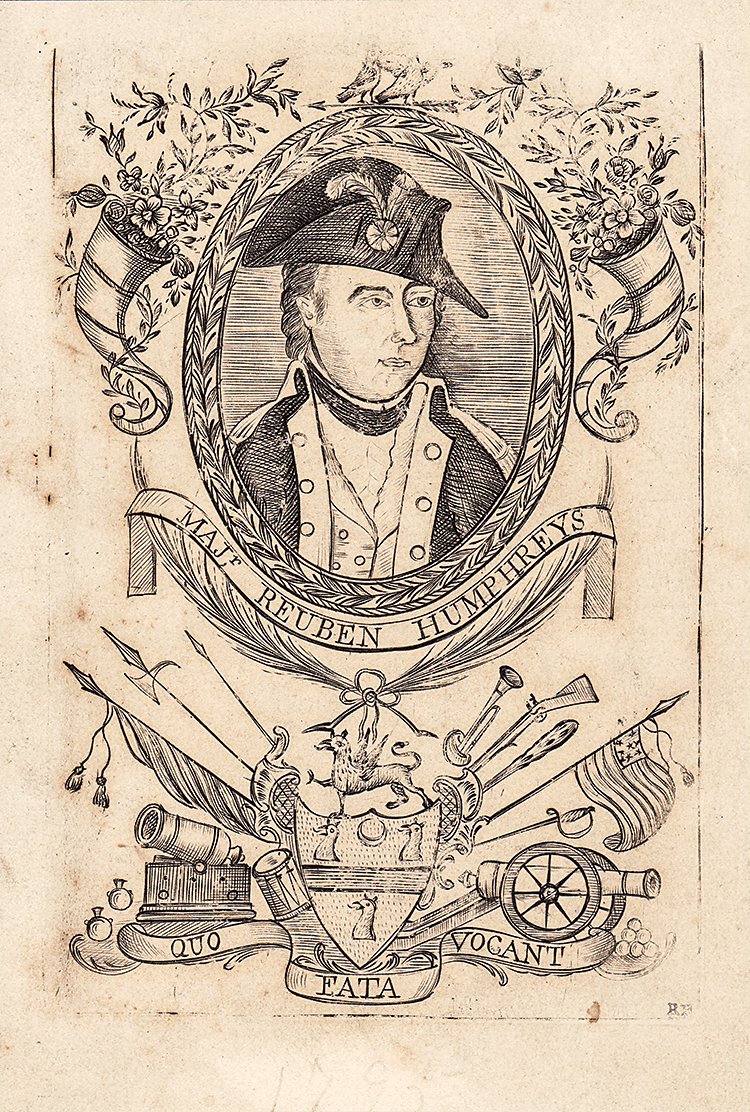
- Fig. 6: Richard Brunton (1749–1832), Portrait of Major Reuben Humphreys, inscribed right lower corner: “RB.” Facsimile line engraving. Original copperplate cited in 1951 in the collection of the New Haven Colony Historical Society. (See William L. Warren, “Richard Brunton—Itinerant Craftsman,” Art in America, 39, no. 2 [April 1951]: 89.) Current location unknown.
Brunton next appears in the historical record in the late 1780s, in the thriving port of Middletown, Connecticut, on the Connecticut River. He may have gone there hoping to establish a new counterfeiting operation. If this was his intention, Connecticut was a good choice: the standard punishments of cropping the tops of counterfeiters’ ears and branding them with a “c” on the cheek or forehead to warn others had been abandoned. Counterfeiters in Connecticut could expect no more than a maximum prison sentence of three years, and offenders who posted bail were often set free on personal recognizance.
In Middletown, as at Boston, Brunton was quick to acquaint himself with local craftsmen. William Hamlin (1772–1869), Rhode Island’s first engraver, credits an English journeyman named Brinton with teaching him engraving when Hamlin served an apprenticeship with silversmith Samuel Canfield at Middletown from 1788 to 1793.8 This was not the only time Brunton mentored a young talent in engraving. When he moved fifty miles to the west, to New Milford, a thriving trading center on the post road from Boston to Philadelphia, he met Gideon Fairman (1774–1827), an apprentice to blacksmith and mechanic Isaac Crane. Brunton encouraged Fairman to pursue a career in the field, which he later did to great success. Although Brunton was dismissed as “an English engraver of no great merit” by historian of early American arts William Dunlap in his 1834 publication, Brunton promoted himself to be a connoisseur of the art of engraving.9
Around this time, he also began engraving family registers with blank separate columns for recording births, marriages, and death dates of families. These are considered to be the earliest preprinted broadside family registers in America and are what he is best known for today.
Shortly after, Brunton secured a commission for a family register from Scottish-born Angus Nickelson, a proprietor of stoneyards and ironworks in New Milford (Fig. 3). The plate is clearly signed “R. Brunton Sculp.” As Nickelson’s youngest son’s birth date of 16 August 1789 is inscribed in Brunton’s hand, but not his death date of 26 September 1791, the plate had to have been completed before the latter date. The life dates recorded here make it possible to identify every sitter in Nickelson’s family portrait, painted by American-born portrait artist Ralph Earl (Fig. 4).
During these years, Brunton and Earl traveled in social circles where literacy was prized.10 In addition to the work the two did for the Nickelson family, Brunton made bookplates for at least two sitters portrayed by Earl posing with their books—Elijah Boardman and Oliver Wolcott. Brunton also made a bookplate for Earl’s doctor, Samuel Cooley.11
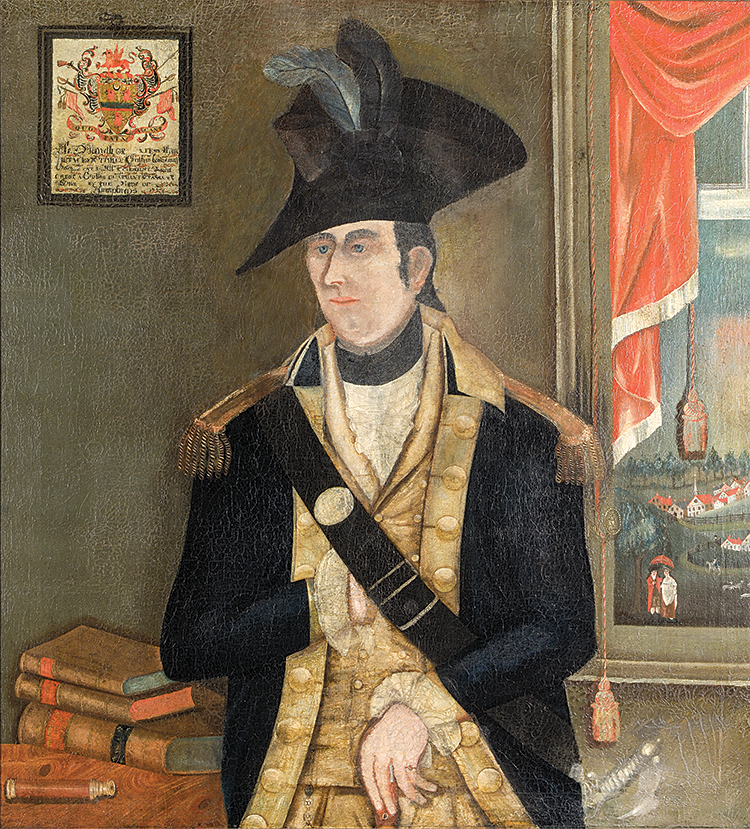
- Fig. 7: Attributed to Richard Brunton (1749–1832), Portrait of Reuben Humphreys. Oil on canvas, 44⅝ × 41 inches. Courtesy of the Connecticut Historical Society, Hartford (1970.2.1). Gift of Joslyn Art Museum, Omaha, Neb., and Mrs. Frank Willis, Oak Park, Ill.
Humphreys’ military uniform and hat were later painted over to show him in the more stately apparel of a judge. Despite careful removal of the overpainting, his portrait has lost much of its painted surface and brilliance.
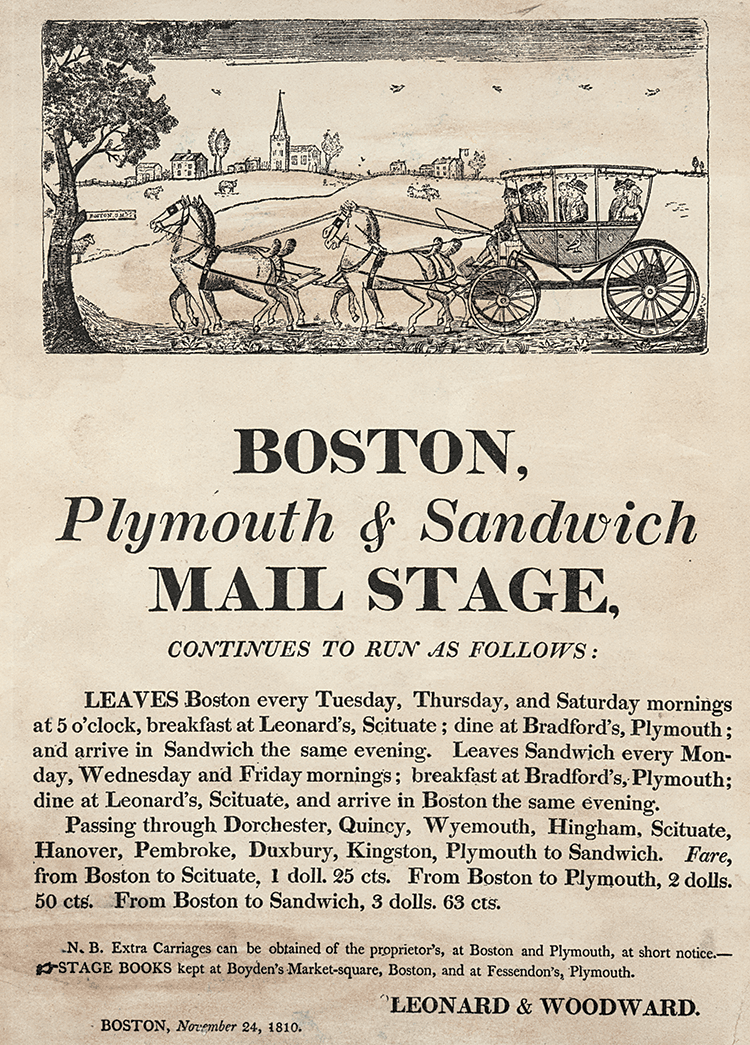
- Fig. 8: Richard Brunton (1749–1832), Boston, Plymouth & Sandwich Mail Stage, November 24, 1810. Broadside printed by Leonard & Woodward, Boston, 6¼ × 3⅛ inches. Courtesy of I. N. Phelps Stokes Collection of American Historical Prints, New York Public Library, New York.
This broadside was one of the most popular advertisements of stagecoach schedules in New England in the 1810s. It is inscribed in block letters “Brunton” on the ground below the directional plaque (“Boston, 3 miles”) attached to the tree. The image was engraved by Brunton while he was an inmate at the Massachusetts state prison.
By this time, Brunton’s opportunities for making an honest living from his craft were dwindling. An influx of printed matter from the Continent, along with the arrival of more skilled engravers offering a greater variety of engraving techniques, put Brunton’s rococo style of line engraving out of fashion. Moreover, his life as an itinerant craftsman, traveling on rough country roads by horseback or stage, may have proved too difficult. Not only was he lame, as reports indicate, he was getting older.
In about 1792, Brunton moved sixty miles northeast, to the prosperous farming town of Suffield, Connecticut. There he took up residence at the home of Gad Rose, and began counterfeiting paper money from plates he cut himself.12 In 1795, Brunton was arrested for counterfeiting bank notes along with silversmith Abiel Pease (1761–1828) in nearby Enfield.13 Pease made bail and was set free, while Brunton was taken to Hartford to await sentencing. Eventually, the charges against him were dropped and he returned to Suffield, where he continued to engrave family registers and even dabbled in portrait painting.
In March 1799, he was caught coining in Woodstock, Connecticut, along with Joel White (1751–1834), brother of silversmith and clockmaker Peregrine White (1747–1834). The two brothers kept a shop there conveniently located on the road to Sturbridge, Massachusetts, where passers of counterfeit money could pick up inventory and rush it to markets in Boston or Hartford before authorities learned of any new bogus issue. This time, Brunton was sentenced to two years hard labor at the notorious New-Gate prison in present-day East Granby, Connecticut, and charged with the cost of his prosecution: $48.72.14
Forced to pursue legitimate work to clear his debt, he made seals for the state of Connecticut and engraved the most ambitious plate of his career—a view of New-Gate prison (Fig. 5). As was his practice he also made gifts of his artistry to those in charge of his care—for the prison warden, he made a portrait engraving bearing his family’s coat of arms (Fig. 6) and pendant portraits of the keeper (Fig. 7) and his wife and daughter.
It is not clear where Brunton went after his release. However, he continued to engrave family registers. He signed one register “RB,” with the date 1805 (held at the American Antiquarian Society); a second, of which three copies are known (one in a private collection, one at the Connecticut Historical Society, and one at Old Sturbridge Village), has the year 1806 on the bottom margin, flanked by two sets of initials, “RB” and “DW.” The latter initials may be those of a bookseller/printer yet to be identified.15
By 1807, Brunton had clearly abandoned any intentions of reforming. After being reported to the authorities as the leader of “a gang of counterfeiters in Pepperell,’ arrangements were made for his capture. In April 1807, he was arrested in Boston with samples of his bogus bills as well as the tools of his trade. In December, he was sentenced to hard labor in Massachusetts state prison in Charlestown for the rest of his life.16
Once again, incarceration bolstered his output of legitimate work. Brunton’s best-known work from his time at Charlestown is an engraving of a stagecoach drawn by four horses, with a village townscape on the horizon (Fig 8). Brunton’s signature bird holding an olive branch in its beak is emblazoned on the carriage door. As the carriage looks ill-suited for early American roads and it was not the practice in this country to crop horsetails, Brunton may have modeled his design on an English print source yet to be identified. Whether the townscape represents an actual townscape is not known either. It is one of the first graphics to feature transportation in the New Republic.
In 1811, after being granted a pardon from the governor on the grounds of ill health and the promise that he would return to his own country,17 Brunton returned to Groton with two printing plates, one signed and dated 1811, and a second signed “RB” (Fig. 9), which he had printed and sold locally. During this time, he also began to favor the more affordable medium of watercolor, which was much more forgiving than engraving for an aging artist with failing eyesight and limited work space (Fig. 10). Despite his claim that he was not long for the world, he lived another twenty-one years before dying in the poorhouse at Groton in 1832.
This article is based on Soldier, Engraver, Forger—Richard Brunton’s Life on the Fringe in America’s New Republic (NEHGS, 2015); extracts are reprinted with permission of the New England Historic Genealogical Society, Boston, Massachusetts. Available from AmericanAncestors.org. The author will hold a book signing on August 6, 2015 at the 58th Annual New Hampshire Antique Dealers Show, Radisson Hotel, Manchester, N.H.
Deborah M. Child is an art historian, independent curator, and the author of The Sketchbooks of John Samuel Blunt (Portsmouth Athenaeum, 2007).
This article was originally published in the Autumn 2015 issue of Antiques & Fine Art magazine, a digitized version of which is available on afamag.com. AFA is affiliated with Incollect.com.
2. Commitment registers, Massachusetts State Prison, 1805–1824, HS9.01/. Series 289X, Massachusetts State Archives, Dorchester, Mass. December 7, 1807, entry cites his age as 58, his place of birth as Birmingham, England. Richard Brunton, apprentice engraver, Birmingham, Warwickshire, England, 1766, Apprenticed to Joseph Troughton, £30/00/00. Board of Stamps Apprenticeship Books at National Archives of the UK, Series IR 1: 56, folio 65.
3. France had joined America in 1778 to defeat Britain.
4. Groton Town Records and Meetings with Births, Marriages, and Deaths. Ancestry.com, image 24/293.
5. Records of the Church of Christ in Pepperell, [Mass.], Vol. 1, p. 48. Pepperell Public Library, Pepperell, Mass.
6. Heald mine aka Corey’s Mine, Mining OD #4, Lyman F. Robbins Collection, Historical room, Lawrence Library, Pepperell, Mass.
7. Kenneth Scott, Counterfeiting in Colonial America (Philadelphia: University of Pennsylvania Press, 2000), 5.
8. Philip J. Weimerskirch, “An Unpublished Obituary of William Hamlin Rhode Island’s First Engraver,” Imprint: Journal
of the American Historical Print Collectors Society 17 (Fall 1992): 5–6.
9. William Dunlap, History of the Rise and Progress of the Arts of Design, in the United States, II (Boston, C. E. Goodspeed & Co., 1918), 177.
10. Like Brunton, Earl was an itinerant who led a life on the fringe. After preparing his famous drawings of the Battle of Lexington to be engraved by Amos Doolittle in 1775, Earl declared his loyalty to the king and passed intelligence to the British. In 1777, Earl escaped to England disguised as a servant to a British officer. He spent the rest of the war years in England perfecting his craft of portrait painting. In 1785, he returned to America, where long-standing money problems caught up with him. In 1786, he was imprisoned in a New York City jail, where he painted portraits until 1788, when he was finally able to pay his debts and secure his freedom. By the time the two men were working in New Milford, Earl’s career was again on the rise.
11. See Elizabeth Mankin Kornhauser, Ralph Earl: The Face of the Young Republic (New Haven: Yale University Press, 1991. The portraits are
in public collections: Elijah Boardman at The Metropolitan Museum of Art, New York. Oliver Wolcott at the Museum of Connecticut History, the Connecticut State Library, Hartford. Brunton’s bookplates for Daniel and Elijah Boardman, titled “D & E. Boardman,” Oliver Wolcott, and Samuel Cooley are in the bookplate collection of the American Antiquarian Society, Worcester, Mass. where they are catalogued by owner rather than engraver.
12. Albert Carlos Bates, An Early Connecticut Engraver and His Work (Hartford: Case, Lockwood and Brainard, 1906), 8.
13. State of Connecticut v. Richard Brunton, trial record, dated 12 December, 1795, Connecticut State Library, State Archives, Hartford.
14. State of Connecticut v. Richard Brunton, trial record, dated 25 March, 1799, Connecticut State Library, State Archives, Hartford.
15. One possible “DW” is bookbinder and stationer David West (1765–1810). Cited in the 1806 Boston directory as a bookseller at 56 Cornhill.
16. Judicial archives, Mass. State Archives, Boston.
17. Council pardon files, 1811, Mass. State Archives, Boston.















